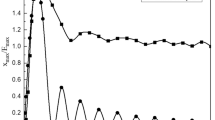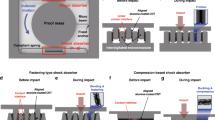Abstract
This paper presents a novel design of mechanical latching shock stops (latching stops) for in-plane shock protection of microelectromechanical systems (MEMS). With three shock protection modes, latching stops are capable of limiting the displacement of silicon suspensions in a compliant manner with efficient energy dissipation. The energy dissipation and the impact force between suspensions and shock stops were analyzed by numerical simulation. The analysis results indicate that latching stops, under a half-sine shock impulse [3000 g (1 g ≈ 9.8 m/s2), 0.15 ms], reduce more than two-third of the impact force compared with hard stops, and additionally, dissipate 33.23% of the total mechanical energy during the latching process. Test specimens of both latching stops and conventional hard stops were developed for comparison. The experimental results demonstrate that test specimens of latching stops achieve more than double the robustness compared with those of hard stops. This new shock protection approach decouples the reliability design from the device design. Moreover, latching stops are compatible with wafer-level MEMS batch fabrication without the requirement of additional processes or materials.








Similar content being viewed by others
References
Ando T, Sato K, Shikida M, Yoshioka T, Yoshikawa Y, Kawabata T (1997) Orientation-dependent fracture strain in single-crystal silicon beams under uniaxial tensile conditions. In: Proceedings of the international symposium on micromechatronics and human science, Nagoya, Japan, pp 55–60
Bogue R (2013) Recent developments in MEMS sensors: a review of applications, markets and technologies. Sens Rev 33(4):300–304
Brown TG (2003) Harsh military environments and microelectromechanical (MEMS) devices. In: Proceedings of IEEE sensors, Toronto, Canada, pp 753–760
Delahunty AK, Pike WT (2014) Metal-armouring for shock protection of MEMS. Sens Actuators A Phys 215:36–43
DelRio FW, Cook RF, Boyce BL (2015) Fracture strength of micro- and nano-scale silicon components. Appl Phys Rev 2(2):021303
Ghisi A, Kalicinski S, Marini S, Wolf ID, Corigliano A (2009) Polysilicon MEMS accelerometers exposed to shocks: numerical-experimental investigation. J Micromech Microeng 19(3):035023
Guo Q, Bebek O, Cavusoglu MC, Mastrangelo CH, Young DJ (2015) A personal navigation system using MEMS-based high-density ground reaction sensor array and inertial measurement unit. In: Proceedings of international conference solid-state sensor actuators microsystem (TRANSDUCERS), Anchorage, USA, pp 1077–1080
Guo Q, Mastrangelo C, Young D (2016) High performance MEMS tactile sensor array with robustness and fabrication simplicity. In: Proceedings of international conference IEEE MEMS, Shanghai, China, pp 877–880
Hopcroft MA, Nix WD, Kenny TW (2010) What is the Young’s modulus of silicon? J Microelectromech Syst 19(2):229–238
Hopf T, Kumar S, Karl WJ, Pike WT (2010) Shock protection of penetrator-based instrumentation via a sublimation approach. Adv Space Res 45:460–467
Horsley DA, Przybyla RJ, Kline MH et al (2016) Piezoelectric micromachined ultrasonic transducers in consumer electronics: the next little thing? In: Proceedings of international conference IEEE MEMS, Shanghai, China, pp 145–148
Huang S, Li X, Wang Y et al (2003) A piezoresistive accelerometer with axially stressed tiny beams for both much increased sensitivity and much broadened frequency bandwidth. In: Proceedings of international conference solid-state sensor, actuators microsystem (TRANSDUCERS), Boston, USA, pp 91–94
Ikuta K, Aritomi S, Kabashima T (1992) Tiny silent linear cybernetic actuator driven by piezoelectric device with electromagnetic clamp. In: Proceedings of international conference IEEE MEMS, Travemunde, Germany, pp 232–237
Khan MI, Mukherjee K, Shoukat R, Dong H (2017) A review on pH sensitive materials for sensors and detection methods. Microsyst Technol 23(10):4391–4404
Lee J, Kwon D, Kim J (2015) Shock protection based on confined self-adjusting carbon nanotube arrays. In: Proceedings of international conference solid-state sensor, actuators microsystem (TRANSDUCERS), Anchorage, USA, pp 287–290
Li X, Dunn PF, Brach RM (2000) Experimental and numerical studies of microsphere oblique impact with planar surfaces. J Aerosol Sci 31(5):583–594
Muhlstein CL, Brown SB, Ritchie RO (2001) High-cycle fatigue of single-crystal silicon thin films. J Microelectromech Syst 10(4):593–600
Naumann M, Mehner J, Lin D, Miller TF (2010) Design and application of flexible stops for MEMS devices. In: Proceedings of international conference IEEE sensor, Hawaii, USA, pp 168–173
Nguyen CTC (2012) The harsh environment robust micromechanical technology (HERMiT) program: Success and some unfinished business. In: Microw. Symp. Dig. (MTT), Montreal, Canada, pp 1–3
Renaud M, Fujita T, Goedbloed M, Nooijer C, Schaijk R (2014) Improved mechanical reliability of MEMS electret based vibration energy harvesters for automotive applications. J Phys Conf Ser 557(1):012071
Rusanov R, Rank H, Fuchs T, Fiedler RM, Kraft O (2016) Reliability characterization of a soot particle sensor in terms of stress- and electromigration in thin-film platinum. Microsyst Technol 22(3):481–493
Srikar VT, Senturia SD (2002) The reliability of microelectromechanical systems (MEMS) in shock environments. J Microelectromech Syst 11(3):206–214
Tao Y, Liu Y, Dong J (2014) Flexible stop and double-cascaded stop to improve shock reliability of MEMS accelerometer. Microelectron Reliab 54(6):1328–1337
Wagner U, Franz J, Schweiker M et al (2001) Mechanical reliability of MEMS—structures under shock load. Microelectron Reliab 41(9–10):1657–1662
Wilson CJ, Beck PA (1996) Fracture testing of bulk silicon microcantilever beams subjected to a side load. J Microelectromech Syst 5(3):142–150
Xu K, Zhu N, Zhan Q, Su W, Zhang W, Hao Y (2015) Design and simulation of micro-platform for MEMS devices applied in shock environment. In: Proceedings of international conference IEEE NEMS, Xi’an, China, pp 445–448
Xu K, Zhu N, Zhang X, Su W, Zhang W, Hao Y (2016) A novel shock protection method based on MEMS compliant latching stopper. In: Proceedings of international conference of IEEE MEMS, Shanghai, China, pp 1125–1128
Yoon SW, Yazdi N, Chae J, Perkins NC, Najafi K (2006) Shock protection using integrated nonlinear spring shock stops. In: Proceedings of international conference IEEE MEMS, Istanbul, Turkey, pp 702–705
Yoon SW, Yazdi N, Perkins NC, Najafi K (2006b) Micromachined integrated shock protection for MEMS. Sens Actuators A Phys 130–131:166–175
Yoon SH, Roh JE, Kim KL (2008) Woodpecker-inspired shock isolation by microgranular bed. J Phys D Appl Phys 42(3):035501
Yoon SW, Lee S, Perkins NC, Najafi K (2011) Shock-protection improvement using integrated novel shock-protection technologies. J Microelectromech Syst 20(4):1016–1031
Younis MI, Jordy D, Pitarresi JM (2007) Computationally efficient approaches to characterize the dynamic response of microstructures under mechanical shock. J Microelectromech Syst 16(3):628–638
Acknowledgements
The authors would like to thank the technical staffs in National Key Laboratory of Science and Technology on Micro/Nano Fabrication, Beijing, China, for their support on the fabrication of test specimens.
Author information
Authors and Affiliations
Corresponding author
Rights and permissions
About this article
Cite this article
Xu, K., Zhang, W. & Hao, Y. Mechanical latching stops for reliability improvement of MEMS in shock environments. Microsyst Technol 24, 3399–3407 (2018). https://doi.org/10.1007/s00542-018-3714-8
Received:
Accepted:
Published:
Issue Date:
DOI: https://doi.org/10.1007/s00542-018-3714-8




